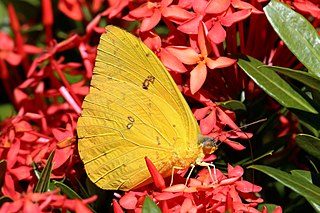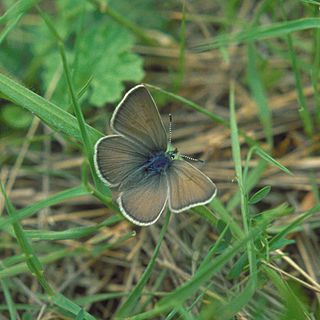
Phoebis sennae, the cloudless sulphur, is a mid-sized butterfly in the family Pieridae found in the Americas. There are several similar species such as the yellow angled-sulphur, which has angled wings, statira sulphur, and other sulphurs, which are much smaller. The species name comes from the genus Senna to which many of the larval host plants belong.

Anthocharis midea, the falcate orangetip, is a North American butterfly that was described in 1809 by Jacob Hübner. It belongs to the family Pieridae, which is the white and sulphurs. These butterflies are mostly seen in the eastern United States, and in Texas and Oklahoma. They eat the nectar of violets and mustards. They tend to live in open, wet woods along waterways, in open swamps, and less often in dry woods and ridgetops. This species is a true springtime butterfly, being on the wing from April to May.

Anthocharis sara, the Sara Orangetip is one of three species in the Sara Orangetip complex. It is a California endemic butterfly with populations extending from Baja California into extreme southwest Oregon. The common name, Pacific Orangetip, is obsolete since its implied distribution includes two separate species.

The Pierinae are a large subfamily of pierid butterflies. The subfamily is one of several clades of butterflies often referred to as the whites.

The tribe Anthocharini is one of the subdivisions of the insect order Lepidoptera, which includes the moths and butterflies. It is a further subdivision of the butterfly family Pieridae and subfamily Pierinae; formerly it was considered a subfamily on its own, Anthocharinae. This tribe includes many, but not all, of the orangetip butterflies.
Euchloe guaymasensis, the Sonoran marble or Sonoran white, is a species of butterfly in the family Pieridae. It is native to Sonora in Mexico and has been seen once in Arizona in the United States.

Euchloe ausonides insulanus, the island marble butterfly, is a subspecies of the Euchloe ausonides and is found in the San Juan Islands in Washington in the northwestern United States. The butterfly was thought to be extinct and was last observed on Gabriola Island, British Columbia in 1908. The species was rediscovered during a prairie butterfly survey in San Juan Island National Historical Park in 1998. After this rediscovery, surveys were conducted throughout the presumed range and found a few populations on San Juan Island and Lopez Island, but no remaining populations in Canada.

Euchloe ausonides, the large marble or creamy marblewing, is a species of butterfly that occurs in western North America. It lays eggs on the terminal flower buds of a variety of plants in the mustard family, including introduced Eurasian species, and the larvae feed on the buds, flowers and fruit of these plants. In California, it has witnessed population declines since the 1980s, especially in the Central Valley and the Bay Area. In Washington, subspecies the island marble butterfly was listed as an endangered species under the Endangered Species Act in 2020.

Euchloe simplonia, the mountain dappled white, is a butterfly found in the mountainous regions of Western Europe. Its main foods are Sinapis, Isatis, Aethionema, Iberis and Biscutella species. Though data are lacking, it is believed that the species is restricted to a small area of the western Alps and is endangered in Europe. The species is closely related to Euchloe naina, and cross-breeding experiments suggest that E. nania may be a subspecies, though this is contested on morphological grounds.

Euchloe ausonia, the eastern dappled white, is a southern European and Palearctic butterfly found mostly to the south and east of its almost indistinguishable relative the western dappled white.

Fender's blue butterfly is a subspecies of Boisduval's blue endemic to the Willamette Valley of northwestern Oregon, United States. The potential range of the butterfly extends from south and west of Portland, OR to south of Eugene, OR. The butterfly is host-specific on the Kincaid's lupine, which it relies on for reproduction and growth. The male and female can be identified by their difference in wing color. The Fender's Blue Butterfly was added to the endangered species list in January 2000, but as of February of 2023, has been reclassified as "threatened". The Fender's blue butterfly population has increased over the past 20 years and projected to increase more through conservation efforts. In Willamette Valley, Oregon, there are currently 90 sites filled with Fender's blue.

Euchloe is a genus of pierid butterflies from the orangetip tribe (Anthocharini). They are Holarctic in distribution, with most species in Europe, Central Asia, and North America. Like other Anthocharini, the American species are usually called marbles; the Old World species are known as dappled whites.

The regal fritillary is a striking nymphalid butterfly found among some of the remaining tallgrass and mixed-grass prairies in the east-central United States. This prairie-specialist butterfly has a characteristic deep orange color and unmistakable dark hindwings with two bands of spots. On the female, both bands of spots are white. However, on the male, the outer band of spots is orange in color. Females also tend to be slightly larger than males. The ventral surface of the hindwings is olive brown to black in color with bold silvery white spots. The wingspan of S. idalia usually measures 68–105 millimetres (2.7–4.1 in). Flight is in the summertime from approximately June to September and adults tend to be swift in flight, coasting close to the ground. It is listed as a species of special concern and believed extirpated in the US state of Connecticut.

Asterocampa celtis, the hackberry emperor, is a North American butterfly that belongs to the brushfooted butterfly family, Nymphalidae. It gets its name from the hackberry tree upon which it lays its eggs. The hackberry tree is the only host plant for A. celtis and is the food source for larvae.

The crystal skipper is a species of butterfly in the family Hesperiidae that is found only along a 30-mile (50 km) stretch of barrier islands in North Carolina. The skipper was first discovered in 1978 and the paper describing it as a full species was published in 2015.

Junonia genoveva, the common mangrove buckeye or mangrove buckeye, is a butterfly of the family Nymphalidae. The species was first described by Pieter Cramer in 1780. It is found in South America and possibly into Central America. The wingspan is 45–57 mm.

Euphyes dukesi, or Dukes' skipper, is a butterfly of the family Hesperiidae. It lives in the eastern United States and in a small portion of southern Ontario, Canada, in three distinct populations. Preferred habitats are shaded wetlands, with various species of sedge plants it uses as host plants for its larvae.

Euchloe hyantis, the pearly marble, pearly marblewing or California marble, is a butterfly in the family Pieridae. It is found on the West Coast of North America from southern Oregon south through California west of the Sierra Nevada crest to northern Baja California, Mexico. The habitat consists of rocky canyons, cliffs, moraines and gravelly flats.
Euphyes berryi, known as Berry's skipper, is a rare species of butterfly of the family Hesperiidae, historically found in wet areas from North Carolina to Florida.

Rocky Prairie is a Puget prairie that is about 56 miles (90 km) southwest of Seattle, Washington, and about 10 miles (16 km) south of Washington's capital city of Olympia. It sits very close to the Millersylvania State Park, the community of Maytown, and the city of Tenino.

















